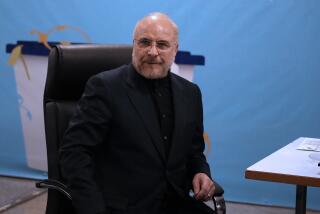Iran’s ‘Isolation’ Is a Dangerous Mirage
The assembly in Tehran this week of two dozen heads of state--including three kings, three crown princes and seven prime ministers--and other high-level officials representing some 55 countries officially marks the eighth meeting of the Organization of the Islamic Conference. It also marks the symbolic death of the United States’ policy of “dual containment” of Iran and Iraq. Specifically, the gathering of European and Asian guest observers as well as Muslim delegates marks the utter failure of the U.S. attempt to isolate Iran.
Policies of restriction or containment through economic mechanisms do not work. In a porous world, sanctions are largely ineffective: Saddam Hussein is still in power in Iraq, Libya is indifferent, and North Korea, Vietnam and Cuba have survived in spite of comprehensive U.S. sanctions. Where U.S. policy has been successful, it has been based on constructive or positive engagement: the ending of apartheid in South Africa and of communism in Eastern Europe, Arab-Israeli peace, protection of intellectual property in China--all have come about because of influence through involvement.
The extension of U.S. policy to the actions of other countries compounds the error. By pressuring Russia to cancel its $1-billion contract to sell nuclear reactors to Iran, the United States unintentionally is taking a risk that could have dire consequences. Iran, determined to develop its nuclear energy capability, is likely to acquire components for nuclear reactor systems through various means, from many sources which could be scattered in different countries. Technically, this effort could result in a piecemeal assemblage of potentially incompatible parts of dubious reliability in an untested reactor of questionable Soviet-designed technology.
As the April 1986 accident at the Chernobyl nuclear power plant in Ukraine spread radioactive fallout across continents, the world learned a harsh lesson: A nuclear accident anywhere is a nuclear accident everywhere. A hastily or secretly designed, untested Iranian nuclear reactor operating with obsolete safety systems will certainly pose a high risk to the health of people and the environment across the Northern Hemisphere.
In these times, the best control on technological matters is through the systemic integration of one country’s technology with that of other countries; this way, no one component of the system could operate independently of the whole system. Tight integration, interdependence and correlation among technologies of different countries provide much more oversight, control and assurance than do unilateral policies of restrictions and isolation. The U.S. deal with North Korea for developing and installing light-water nuclear reactors is a step in the right direction and is an example of the realization of this new paradigm in foreign policy, which should be duplicated.
When it comes to building relationships, the recipe for Iran should be the same that the U.S. followed in shedding its inhibitions concerning such ideological adversaries as the Soviet Union, China and Vietnam. In the case of Iran, the U.S. may want to consider as a goodwill overture the unblocking of the Iranian assets frozen here since the 1980 hostage crisis. An opportunity to do so can present itself at the next occurrence of a natural or environmental disaster in Iran, in which context the U.S. would unfreeze the assets in order to enable the Iranian government to cope with the humanitarian requirements of the situation, with no further strings attached.
Willingness on the part of either the U.S. or Iran to admit that one day there will be a meaningful relationship between the two is the first step toward that eventuality. The next step would be to conceive of the circumstances that can bring about the relationship--not conditions precedent to talks or anything like that, but rather to imagine the relationship itself as it would be. In that relationship, all other external issues like “terrorism,” the status of Jerusalem and weapons of mass destruction may be discussed.
The U.S. needs to see Iran as part of the solution to the strategic challenge in the Middle East. But first, Washington and Tehran must simply be able to communicate on matters of mutual interest. Resolving their differences can come later, much later.
As the gathering of dozens of nations in Tehran this week demonstrates, Iran is isolated mostly in the minds of U.S. policymakers. And it is U.S. interests that suffer. By not reckoning with Iran as a major player in the Middle East, the U.S. directly deprives the American private sector of a lucrative market, widens the gap with its allies, indirectly keeps Israel’s security in limbo and deepens the stagnation in the Arab-Israeli peace process. A fresh and bold approach to U.S.-Iran relations is not only desirable; it is imperative for the United States’ national interests in the Middle East, Europe, Central Asia, and North and East Africa.
*
Najmedin Meshkati is an associate professor of engineering at USC. E-mail: [email protected]. Guive Mirfendereski is a professor of international law at Brandeis University. E-mail: [email protected]
More to Read
Sign up for Essential California
The most important California stories and recommendations in your inbox every morning.
You may occasionally receive promotional content from the Los Angeles Times.










